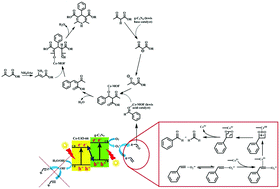g-C3N4@Ce-MOF Z-scheme heterojunction photocatalyzed cascade aerobic oxidative functionalization of styrene
Abstract
A special composite of the cerium-based metal–organic framework (Ce-UiO-66) modified with graphitic carbon nitride nanosheets (g-C3N4) has been synthesized. In order to make a comparison, a series of composites comprising g-C3N4 and Ce-MOF were synthesized as well. Their structural features were investigated using Fourier transform infrared spectroscopy (FT-IR), powder X-ray diffraction (PXRD), sorption of nitrogen (BET and BJH), thermogravimetric analysis (TGA), scanning electron microscopy (SEM), energy dispersive X-ray (EDX), transmission electron microscopy (TEM), X-ray fluorescence spectroscopy (XRF) and diffuse reflectance UV-Vis spectroscopy (UV-Vis DRS) and electron spin resonance (ESR) techniques. According to the obtained results, it was found that nanosheets of mesoporous g-C3N4 act as linkers between the cerium sites, playing a critical role in the formation of composites. In fact, the embedded g-C3N4 nanoparticles in the Ce-MOF cause a new kind of meso-porosity. Moreover, the coordination of nitrogen atoms in the graphitic carbon nitride structure to cerium atoms of the crystal brings about substantial changes in the optical properties, increasing the photoreactivity. On the other hand, since there is a physical contact between Ce-UiO-66 and g-C3N4 in the composite, the unaltered pore volume and optical properties lead to the formation of a physical mixture rather than a composite. The g-C3N4@Ce-MOF as a photocatalyst was employed in photocatalytic aerobic oxidative Hantzsch pyridine synthesis of styrene and indicated high performance under visible light. The stability and reusability of g-C3N4@Ce-MOF were also examined and showed high efficiency up to the 5th run. Besides, the PXRD and FT-IR analyses taken from the retrieved g-C3N4@Ce-MOF nanocomposite confirmed the catalyst stability after the completion of the cascade aerobic oxidative reaction. Despite the photocatalytic performance, the synergistic effect of open metal sites in the MOF as Lewis acid and nitrogen in g-C3N4 have greatly improved the efficiency of the catalyst. Moreover, the study of the reaction mechanism using ESR indicates the positive effect of composite formation on the performance of the photocatalytic aerobic oxidation reaction by the superoxide radical (O2˙—), as a selective oxidant species.



 Please wait while we load your content...
Please wait while we load your content...